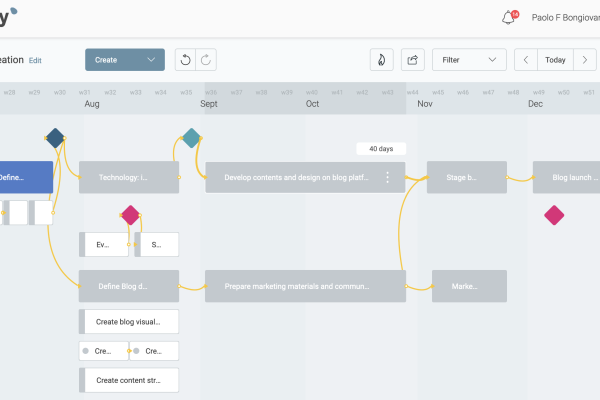
How to plan for uncertainty in your startup
Francesco Marcatto30 Oct 17
Table of contents
What is the best practice for managing your startup team in a productive way? It can be easy to slip into micromanaging especially when you are genuinely interested in moving your business forward and, as many of us, you are a control freak.
Micromanagement is demeaning for your team, nobody likes to be told exactly what to do, but also extremely inefficient. It’s like writing the instructions for a friend to play chess on your behalf, as the Heath brothers wrote in their best-seller Made to Stick, ‘You know a lot about the rules of the game and you may know a lot about your friend and the opponent. But if you try to write move-by-move instructions you’ll fail. [...] The first time the opponent makes a surprise move, your friend will have to throw out your carefully designed plans and rely on her instincts’.
On the other hand, giving vague instructions could lead to inefficiency: employees don’t understand exactly what they have to do, have to guess what’s more important and what instead could be delayed, and they could work at cross purposes.
The Commander’s Intent
The [Commander’s Intent](https://en.wikipedia.org/wiki/Intent_(military) (CSI) is a smart tool that has been developed by the U.S. Army to help them plan in the face of extreme uncertainty. The CSI explains the desired outcome of an operation. Instead of being micromanaged, subordinates are shown what a successful mission will look like, and empowered to use their skills and knowledge to reach the desired outcome.
It then doesn't matter if something unexpected occurs, the soldiers will still be guided to reach the desired outcome.
The origin of the CSI
The U.S. Army had the same planning problem that many organisations have today. Company commanders created lengthy battle plans that specified pretty much anything, from which equipment to use, to what individual soldiers will do at a particular moment in time. Micromanagement at its best.
Let’s say that your aim is to capture a key hill and intelligence reports say that the weak spot is on the east side, so you write down a detailed plan explaining all the moves your men will do to conquer the hill by attacking from the weak side. But once on the field, the soldiers discover that things are different now and the east side has been heavily fortified: what should they do now? If they follow the original plan strictly, they risk a slaughter, if they try something different (scout the other paths for another weak spot or lure away the enemy with a diversion) the thorough plan has been a waste of time.
If you micromanage, when things change, and things will change, your original plan becomes useless, which is why the US Army had to find a better way to plan their operations.
The Commander’s Intent in business
The core idea behind the CSI is that, rather than apply tight command and control, leaders should provide a clear sense of the outcomes they seek and the parameters they will accept. In business, this means that you should tell your team where you want to go and why you need to get there.
This has multiple benefits:
- Easy prioritisation. When you set a clear goal, prioritisation becomes easy: anything that leads you closer to the desired goal has a high priority, everything else can wait.
- Employee’s empowerment. When employees are given a chance to decide how to get done their work, they increase their productivity and tend also to find innovative solutions to complicated problems.
- Unpredictable events won’t ruin the plan. What will your team do when something unexpected happens? By using the CSI your employees will be free to improvise and take initiative to reach the desired goal anyway, instead of just freezing or calling for another meeting.
How to apply the CSI to your business
In the Army, commanders are told to complete the following two sentences when developing a CSI:
‘If we do nothing else during tomorrow’s mission, we must ____________________’
‘The single, most important thing that we must do tomorrow is __________________’
This way they are nudged into highlighting the most important goal of a mission, weeding out superfluous elements.
A smart startup leader should do the same, and clearly communicate what’s the most critical objective for her team. There are, however, some other key elements that could be added for developing a well-crafted CSI that really delivers.
Adding why
In startups, it’s also important to communicate why you’re doing something. Unlike in the army, your team members won't follow orders just because someone more senior has set them. Indeed, we apply our motivation and talent to things we see the point of doing, the things we know why we’re to do them.
Adding time
The Army’s CSI is based on a very narrow time frame (‘tomorrow’), in a business context, however, it’s usual to have objectives that take longer to be reached. People like procrastinating, so set a realistic deadline and make it explicit in your CSI.
Adding metrics
The Commander's Intent is great because it gets you thinking about what outcome you want, rather than on what tasks you and your team need to do. You can take this even further by defining what metrics you want to achieve, what real ‘success’ would look like, what would be merely ‘okay’ and what would make you ‘stop’ and reconsider your journey. This will not only help you focus but help you review your work effectively and be in a better position to make strategic changes to help your startup survive.
The CSI for Startups Template
Ok, let’s make it concrete. Here’s a template for starting to use the Commander’s Intent right now in your startup.
** Our goal is to ............................................................ because ............................................................ and we have to do it before .............................. .**
Success would be ............................................................ .
It would be okay if ............................................................ .
We need to reconsider if ............................................................ .
An example
Our goal is to have people to sign up in the pre-launch landing page of our new app because we need to have a userbase to contact again at launch and we have to do it before 30 October 2017.
Success would be to have 20 or more signups
It would be okay if we have from 5 to 19 signups
We need to reconsider if we have less than 5 signups
A tool for planning for uncertainty
Don’t let uncertainty ruin your plans! If you are searching for a modern project management tool built around the idea of reducing uncertainty, Mindiply is what you are looking for, sign up for early access here.








